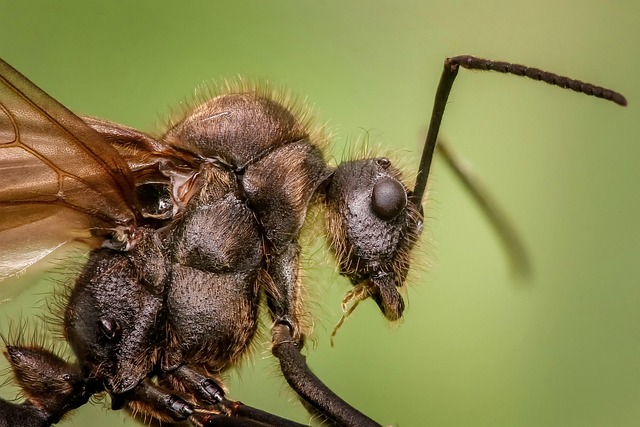Psocids (book lice) are versatile insects found in diverse settings, thriving in dry, secluded areas with organic matter. They pose significant risks in commercial spaces due to their rapid reproduction and potential damage to assets. Effective commercial psocid extermination relies on proactive inspection and tailored solutions from pest control experts. Identifying breeding sites, such as hidden areas with moist organic materials, is key to successful extermination and prevention of health risks associated with infestations. Integrated Pest Management (IPM) strategies offer comprehensive, humane solutions by combining sanitation, physical controls, and targeted treatments for commercial psocid extermination.
Psocids, often overlooked, can swiftly turn into a pest problem in commercial settings. Understanding their behavior and breeding patterns is crucial for effective prevention. This article delves into the world of thorough inspections as a powerful tool for identifying psocid activity and breeding sites. We explore common areas of risk and provide essential strategies for successful commercial psocid extermination and long-term prevention, ensuring a pest-free environment.
Understanding Psocids: Behavior and Breeding Patterns
Psocids, also known as book lice, are tiny insects that belong to the Psocidae family. Despite their name, they have no relation to lice and are not parasites or vectors of diseases. These creatures are incredibly adaptable and can thrive in a wide range of environments, from forests to urban settings. Understanding their behavior is crucial for effective commercial psocid extermination.
Psocids typically breed in dry, secluded areas where they can find organic matter to feed on. Common breeding sites include cracks in walls, floorboards, furniture crevices, and stored materials like books, fabrics, or wooden products. They have a short life cycle, with eggs hatching into nymphs that mature quickly. This rapid reproduction makes them challenging to control once established, especially in commercial spaces where they can infest large areas within buildings.
The Role of Thorough Inspections in Commercial Settings
In commercial settings, thorough inspections are paramount for identifying and addressing psocid activity and breeding sites. Professional pest control experts understand that psocids, also known as book lice, can quickly infest and cause damage to a wide range of materials, from documents and books to textiles and food products. Regular, meticulous inspections enable these specialists to pinpoint hidden populations and potential breeding grounds before they escalate into full-blown infestations. This proactive approach is crucial for commercial psocid extermination, as it not only minimizes disruption to business operations but also helps preserve valuable assets and maintain a hygienic environment.
By integrating rigorous inspection protocols into their service offerings, commercial pest control providers can offer tailored solutions that address the unique challenges faced by businesses. This involves scrutinizing every nook and cranny of affected areas, including hard-to-reach spaces behind furniture, under baseboards, and within wall crevices. Through this comprehensive approach, professionals can identify not only active psocid colonies but also potential entry points and environmental factors that contribute to their presence, ensuring effective and lasting commercial psocid extermination.
Identifying Breeding Sites: Common Areas and Potential Risks
Identifying breeding sites is a crucial step in effective commercial psocid extermination. Psocids, often referred to as book lice, thrive in environments with high moisture levels and organic materials. Common areas where these breeding sites can be found include basements, attics, behind walls, under floors, and within voids of structures. In commercial settings, such as offices, warehouses, or hotels, psocids may hide in stored documents, books, furniture, or even electrical equipment.
Potential risks associated with these breeding sites are manifold. Unaddressed psocid infestations can lead to damage to valuable items, such as historical documents or wood furnishings. Moreover, they pose health risks to occupants by triggering allergies and respiratory issues. Regular inspections should focus on identifying these hidden areas to ensure successful extermination and prevent future recurrences.
Effective Strategies for PSOCID Extermination and Prevention
Effective strategies for PSOCID extermination and prevention are crucial in maintaining a pest-free environment, especially in commercial settings. One of the most comprehensive approaches involves thorough inspections. Regular and meticulous assessments of spaces, particularly in hidden areas like cracks, crevices, and behind walls, can reveal psocid activity and breeding sites early on. This proactive measure allows for swift action, preventing infestations from escalating.
Implementing integrated pest management (IPM) practices is another effective method for commercial PSOCID extermination. IPM combines various strategies such as sanitation, physical controls, and targeted treatments to manage pests humanely and efficiently. By addressing psocids’ specific needs and behaviors, including their preference for moisture and organic matter, these practices disrupt their breeding cycles and reduce the need for chemical interventions.
Psocid infestations can significantly impact commercial settings, requiring proactive measures. Through a combination of understanding these tiny invaders, conducting thorough inspections, and implementing effective strategies, businesses can achieve successful Psocid extermination and prevent reoccurrence. Regular assessments of breeding sites, especially in hard-to-reach areas, are key to maintaining a psocid-free environment. By adopting integrated pest management techniques, commercial spaces can create a hygienic and unobtrusive atmosphere, ensuring customer satisfaction and maintaining a healthy reputation.
